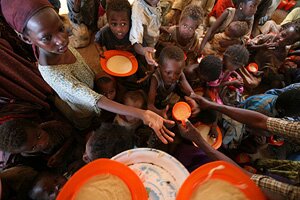 Bartamaha (Nairobi):- Health officials in Sanaag, a region to the northeast of Somalia’s self-declared republic of Somaliland, say food insecurity has seriously affected 22 villages in a mountainous area, where more than 200 children have been found to be malnourished.
Bartamaha (Nairobi):- Health officials in Sanaag, a region to the northeast of Somalia’s self-declared republic of Somaliland, say food insecurity has seriously affected 22 villages in a mountainous area, where more than 200 children have been found to be malnourished.
Sahra Hassan, an official in Somaliland’s Health Ministry, told IRIN the cases of malnourished children were recorded in Mayd, Xaad and Ceel-Kibir, all in the northeastern region of Sanaag.
“At least four malnourished children from the mountain areas were admitted to Erigavo hospital,” Hassan said. “We are also providing medication and nutritional food, provided by the IMC [International Medical Corps] to the children in the affected areas.”
The September-October post-Gu nutrition updateby the Food Security and Nutrition Analysis Somalia unit (FSNAU), rated the nutrition situation of most livelihood zones in Sanaag as on “alert”, with a small section of the west Golis/Guban livelihood zone to the west of Sanaag in “a serious nutrition phase”.
“The ‘Alert’ nutrition situation was mainly attributed to the improved household food security, resulting from the favourable Gu 2010 rains received in that region,” according to the update.
FSNAU said: “Results using the WHO [World Health Organization] growth standards and estimated by the CDC probability calculator, reported a GAM [Global Acute Malnutrition] rate of less than 8.5 percent and a SAM [Severe Acute Malnutrition] rate of less than 0.6 percent.”
Sanitation concerns
“Also of concern is the access to safe water, sanitation and health facilities, which are limited to less than 50 percent of the assessed population,” the agency said. “Poor access to milk for consumption or sale, mainly due to poor livestock body conditions and out-migration, are an aggravating factor in the pastoral population in the area during this time of year.
“The proportion of children assessed that had reportedly fallen ill in the two weeks prior to the survey was high at 26.5 percent,” the agency said. “The proportion of children reported to have suffered from diarrhoea in the two weeks prior to the assessment was 9.4 percent. However, a higher number of children were reported to have suffered from pneumonia (14.3 percent) and febrile illness (14.8 percent).”
Ettie Higgins, the Hargeisa field officer for the UN Children’s Fund (UNICEF), said international aid organizations were providing outpatient treatments to malnourished children in Sanaag region.
“UNICEF, working in partnership with Somaliland Red Crescent Society and International Medical Corps, is supporting outpatient treatment and care service provision for children suffering from severe acute malnutrition,” Higgins said. “In addition, support is being provided to improve the nutritional status of pregnant women through multiple micronutrient supplementation, thus preventing severe micronutrient deprivation and ensuring a good nutrition start to an infant’s life during the neonatal phase.”
In remote areas like Sanaag, Higgins said, ready-to-use therapeutic foods such as Plumpy’nut was an excellent form of treatment for malnutrition.
“However, for cases of severe acute malnutrition, with medical complications, babies and infants are admitted to one of the three UNICEF-supported stabilisation centres, housed in the hospitals of Hargeisa, Boroma and Burao,” she said.
=================================
Source: IRIN



